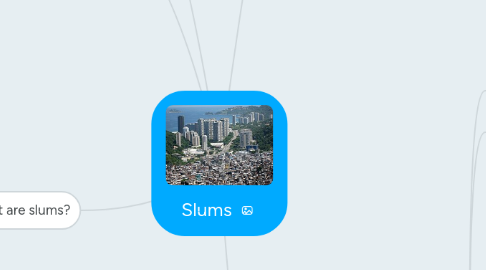
1. Who lives in slums?
1.1. 1 billion of the world’s population live in slums
1.2. Most slums are found in LEDCs
2. What are slums?
2.1. Slums are communities with a lot of small shacks to provide people living in poverty with houses
2.2. Slums are communities with a lot of small shacks to provide people living in poverty with houses
2.3. Slums are a place with informal housing
2.4. Over populated
2.5. People live there when they don’t have much money
2.6. Poor people live
2.7. Slums exist because people don’t have proper places to live so they live there
2.8. 60% of Kenya lives in 5% of it’s land
2.9. No access to clean water and adequate sanitation
2.10. Increase urban poverty
2.11. Economy inequality
2.12. Globalism
2.13. Rural to urban migration
3. How can we help?
3.1. 39% of the world’s population live in slums in 2000 but thanks to the global goals there was an improvement and in 2012 it decreased to 33%
3.2. An estimate of 863 million people still live in slums in 2012
4. What challenges do they face?
4.1. They can only use the bathroom twice in a day. In the morning at 4 to 5 am and in the night at 10:30
4.2. They use the bathroom on railway tracks
4.3. They can only use the bathroom twice in a day. In the morning at 4 to 5 am and in the night at 10:30
4.4. They use the bathroom on railway tracks
4.5. People have to wait all day for their water because there is no specific time
4.6. Toilets are far from slums and have very long lines
4.7. Overpopulation
4.8. No room for anything.
4.9. Living room dining room bedroom kitchen all in one room
4.10. People shower outside with tiny buckets and cold water.
4.11. There showers are in the open
4.12. There bathrooms are far away from slums
4.13. Waste from bathroom goes into the river (no tubes straight in)
4.14. 1 million people live in 1 square mile
4.15. There are very tiny houses with a lot of people crammed inside
4.16. There are tiny paths between houses
4.17. A slum in South Africa has more than 1.8 million people
4.18. There is only 1 room so people are usually cramped
4.19. When there is rain houses are only covered with cloths
4.20. Corrugated iron is used for the roof
4.21. Waste wood, cardboard and plastic are used for the walls so they are not so strong to hold rain
5. Where are slums?
5.1. There are a lot of slums in the city area so people have more access to informal jobs
5.2. Slums are generally close to rivers so people have more access to water dirty or not
5.3. Mumbai
5.3.1. Houses made with scrap material
5.3.2. Lack access to clean water and adequate sanitation
5.3.3. (watch slumming it)
5.3.4. Dharavi is the biggest slum in the world
5.3.5. People look through garbage for
5.3.6. 13 million out of 21 million people in mumbai live in slums
5.3.7. Most of the people that live in the slums live under 1USD dollar a day.
5.3.8. Average of 1458 people have to share 1 toilet
5.3.9. In Dharavi 90% of the slum housing units are illegal
5.3.10. 3USD every month
5.3.11. 1 million people live in 1 square mile
5.4. Kenya
5.4.1. Slums in kenya started in 1918
5.4.2. One big slum in in Nairobi
5.4.3. Water is very polluted and garbage surrounds the slums
5.4.4. The slums are very dangerous and are full of crime
5.4.5. They pay about 2.50SGD every month to live there
5.4.6. Wooden shacks, mud floor
5.4.7. In kenya everyone is trying to improve the slum
5.4.8. In one of the slums in Kenya there is now a clinic, police station, street lights and free wifi
5.4.9. In kenya shipping containers were turned into clinics
5.5. Brazil
5.5.1. Slums in brazil known as favelas
5.5.2. Most favelas are located on slums and close to high end neighborhoods
5.5.3. Favelas first started in brazil when soldiers had no money or homes
5.5.4. Today 1 out of 5 people in Rio de janeiro live in favelas
5.5.5. High rate of death and diseases
5.5.6. For a very long time people in slums have no running water, no bathrooms, no electricity and a lot pollution
5.5.7. Some people started to take action by owning the land and worked on improving the situation.
5.5.8. Now most slums have running water and electricity
5.5.9. More than 85% of brazil live in urban area
5.5.10. Many people that migrate from rural areas to rio de janeiro live in favelas
